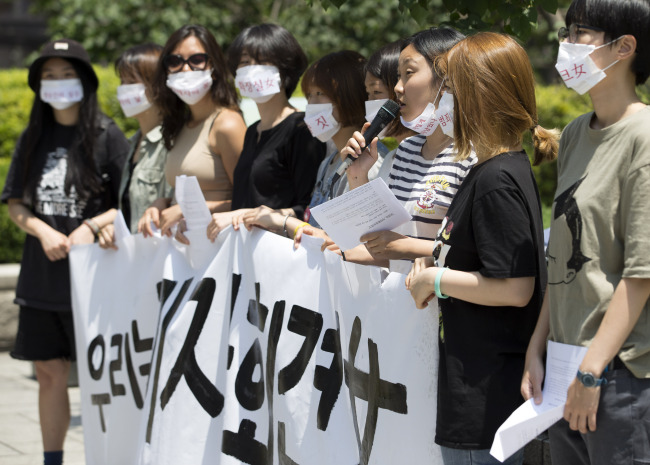A number of women’s groups expressed concerns over the government’s new measures to combat crimes against women, such as forced hospitalization of the mentally ill and getting rid of public unisex bathrooms, calling them impractical and even discriminatory.
In a joint press release issued by nine agencies, including the ministries of gender equality and justice, the government on Wednesday introduced a number of measures to protect women against violent crimes.
They included installing more surveillance cameras in public spaces, making it mandatory for ex-convicts with a history of mental illness to get medical treatment, as well as hospitalizing individuals with mental conditions should they show signs of violent or criminal behavior.
 |
Participants hold a press conference denouncing media reports that depict women as objects in Seoul on Wednesday. (Yonhap) |
The announcement came in the aftermath of the recent Gangnam murder case, in which a 23-year-old woman was stabbed to death by a man with a history of schizophrenia who said he killed her because he hated women. He had no contact with the victim prior to the incident that occurred at a public bathroom in Seoul’s Gangnam district last month.
Kim Min Moon-jung, co-representative of women’s rights group Womenlink, said a number of studies have shown that surveillance cameras are not very effective in crime prevention. “The footage may be helpful for detectives when they are trying to track down the suspect after a crime has already been committed,” she told The Korea Herald.
“But we’ve seen in previous studies that (the surveillance cameras) don’t decrease the number of violent crimes against women.”
Jang Suh-yeon, an attorney at Human Rights Law Foundation, said removing public unisex bathrooms cannot change the core of the problem.
“It’s not just public bathrooms where women have been physically or sexually assaulted,” she said in an email to The Korea Herald. “We’ve seen many women who said they were abused at many different places, such as public parks, underground parking lots and narrow alleyways. Violence against women cannot be solved simply by getting rid of certain public properties.”
Both Kim Min and Jang said forced hospitalization of mentally ill people is not the best way to tackle the problem. “It’s just going to create unnecessary stigma and prejudice against the mentally ill,” Kim Min said.
Kim said instead of such “impractical” measures, the government should make more efforts to educate the public, especially on gender equality and sexual violence. She said many of female rape victims in South Korea do not trust the justice system as very often the authorities question the credibility of their narrative and even blame them for what happened. “The problem is also cultural,” she said.
Upon the release of the new measures, the Ministry of Gender Equality and the Korea Communication Standards Commission together announced that they will revise a set of administrative rules that all broadcasters are encouraged to follow, to eliminate content that promote gender-based prejudice or violence.
Its tentatively revised version includes an article that says, “broadcasters must not blame victims of sexual violence for what happened to them” and “broadcasters must not feature prejudiced thoughts against a certain gender, in regards to how they should behave, how they should look, and what roles they should have (at home and society).”
However, the team of reviewers at the KCSC scheduled to look through the tentative version does not include any women.
Last year, professor Shim Mi-seon from Soon Chun Hyang University conducted a six-month study monitoring all broadcasters and their shows for the Ministry of Gender Equality. She said she witnessed a huge amount of gender discrimination and stereotypes in TV shows.
Among many of her findings, Shim said many male news anchors in general were significantly older -- on average by 10 to 20 years -- than their female counterparts. In current affairs shows, most “experts” such as professors, medical doctors or attorneys, were also male, she said. Also, many news shows would feature interview clips of ordinary citizens who would blame female victims for sexual and other forms of violence -- instead of criticizing the male perpetrator. Such comments include: “I’m sure the woman must have done something wrong, too” or “So why did she wear such a short skirt that night?”
“I found out that someone did similar research 10 years ago,” she said. “And I was surprised to find out that not much has really changed.”
By Claire Lee(
dyc@heraldcorp.com)







![[Today’s K-pop] Blackpink’s Jennie, Lisa invited to Coachella as solo acts](http://res.heraldm.com/phpwas/restmb_idxmake.php?idx=644&simg=/content/image/2024/11/21/20241121050099_0.jpg)
